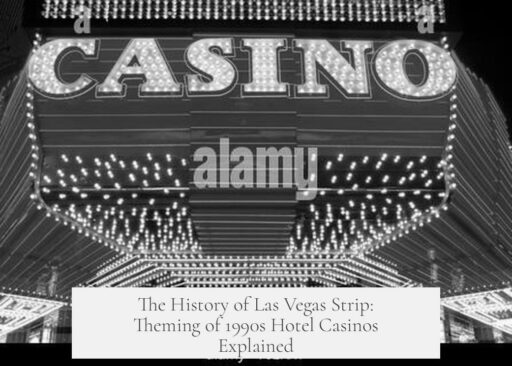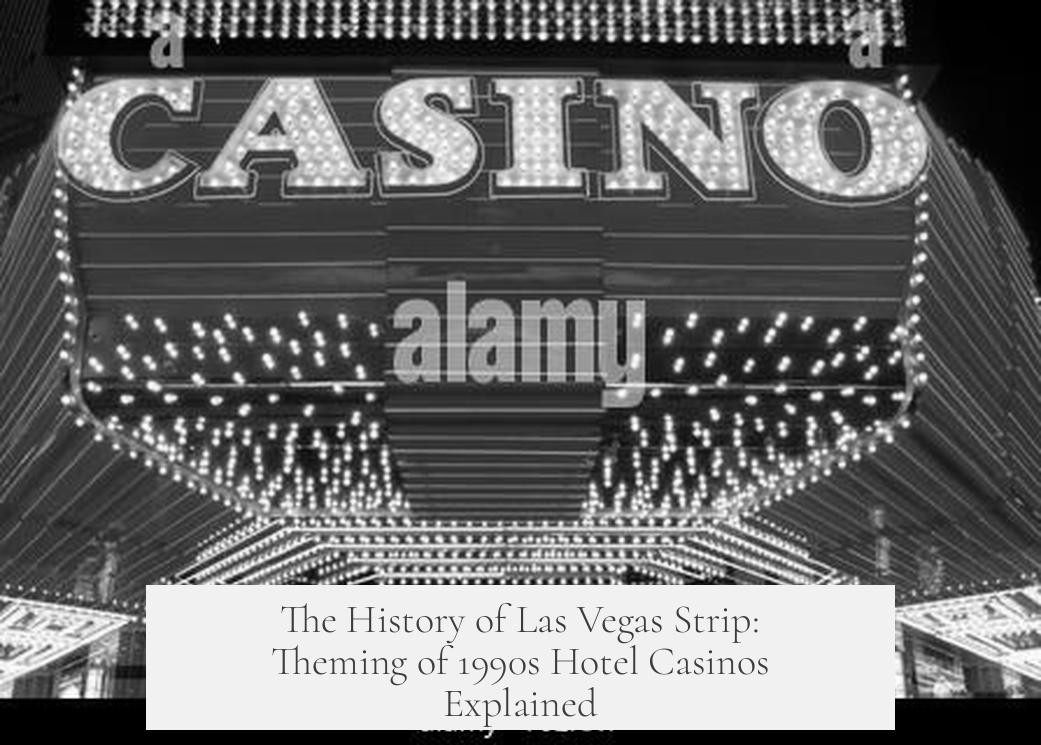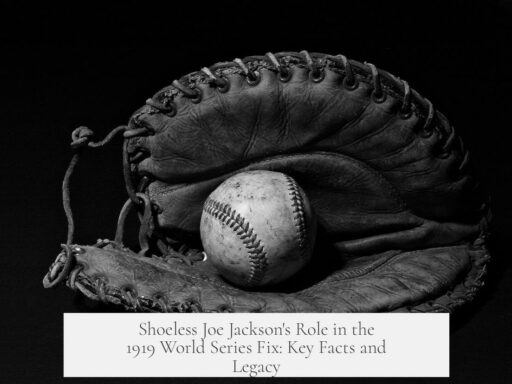The new “Strip” in Las Vegas, especially the hotel casinos constructed through the 1990s, earned their strong theming to differentiate themselves as gambling lost its novelty and competition grew. These themed resorts combined immersive experiences with integrated amenities to attract diverse visitors beyond gamblers.
The history of the Las Vegas Strip’s development unfolds through three distinct stages of casino resort evolution. The first generation, starting from the mid-20th century, was marked by modest resorts with limited capital and relatively cheap land. Casinos had simple setups: a central casino, theater, and restaurants accompanied by nearby two-story hotel buildings. Room counts were modest, typically 200–300, but expansions soon followed. Landmark resorts like the Sands and Dunes added high-rise towers in the late 1950s. These early casinos leaned on Western or broad international aesthetics. For example, Caesars Palace (1966) showcased emphatic Roman theming, while Circus Circus embraced a circus big top feel. However, most had only basic styling, reflecting the fact that legalized casino gambling itself was a new concept for visitors.
The second generation of casino resorts, from around the late 1960s to the 1980s, brought larger, integrated complexes. They featured a large hotel tower on top of a sprawling base housing casinos, multiple restaurants, retail shops, bars, and nightclubs. The International (now Westgate) exemplified this approach at its 1969 opening with 1,500 rooms aimed at attracting a broad guest base. The original MGM Grand followed this model, spawning imitators in other gambling markets like Atlantic City and Reno. Despite improvements in scale and service, these resorts still lacked the pronounced thematic identities that would later define the Strip’s character.
The third generation of resorts began with the opening of The Mirage in 1989. This resort combined size, integration, and thematic design on a scale unseen before. With gambling now an established and widespread entertainment form, resort operators understood the need for unique selling points beyond games. Theming became a marketing tool to create immersive storylines that made each property distinct. The success of Caesars Palace with its thoroughly executed Roman motif served as an inspiration, prompting others to adopt strong visual themes and narratives. The Mirage exploited a tropical island theme, complete with erupting volcano effects, setting a new standard for experiential resorts.
Several factors explain why strong theming dominated hotel casino design through the 1990s:
- Gambling’s familiarity: As casino games became commonplace, themes offered a way to differentiate resorts and attract a broad audience.
- Access to capital and mainstream acceptance: Greater funding enabled ambitious, themed constructions. Casinos increasingly presented themselves as normal vacation destinations, integrating dining, entertainment, and shopping alongside gaming.
- Family-friendly intent: During the 1990s, Las Vegas aimed to shed its seedy image. Resorts adopted bright, accessible designs that encouraged families, not just gamblers, to visit.
Hotels like Excalibur (castle/medieval), Luxor (Egyptian pyramid), New York-New York (cityscape), and Treasure Island (pirate adventure) reflected this trend, creating thematic environments that turned resorts into attractions offering more than just gambling. These designs boosted visitor numbers and lengthened stays by engaging guests with entertainment and dining aligned with the themes.
After 2000, Las Vegas saw a shift away from overt theming. Resorts such as Wynn Las Vegas (opened 2005) pursued a sleek and modern aesthetic. The move coincided with a change in marketing: from a family-friendly resort town to a “what happens in Vegas” adult playground. The strongly themed resorts of the 1990s began to feel dated. New developments opted for luxury and understated elegance over explicit themes. Properties like Aria showcased generic high-end hotel design rather than a themed narrative. Yet a few themed landmarks, like the Luxor pyramid, remain iconic examples of the prior era.
In summary, the new “Strip” hotels built through the 1990s featured robust theming to capture visitor attention in an increasingly competitive market. The themes offered memorable experiences, supported family-oriented tourism, and leveraged fresh capital and cultural acceptance. Subsequent decades saw the Strip refine its image toward adult-centric luxury, making the 1990s a distinct period of thematic innovation.
- The Las Vegas Strip developed in three stages: modest early resorts, larger integrated second-generation resorts, and thematically rich third-generation resorts starting with The Mirage.
- Strong theming in 1990s hotel casinos helped differentiate properties as gambling became mainstream and no longer a novelty.
- Theming supported a family-friendly image, promoting resorts as vacation destinations with varied entertainment beyond gaming.
- Access to capital and increased legitimacy drove ambitious, large-scale themed developments.
- Post-2000, Las Vegas shifted toward luxury and adult appeal, leading to a decline in overt theming.
The History of the New “Strip” in Las Vegas: Why Do 1990s Hotel Casinos Have Such Strong Theming?
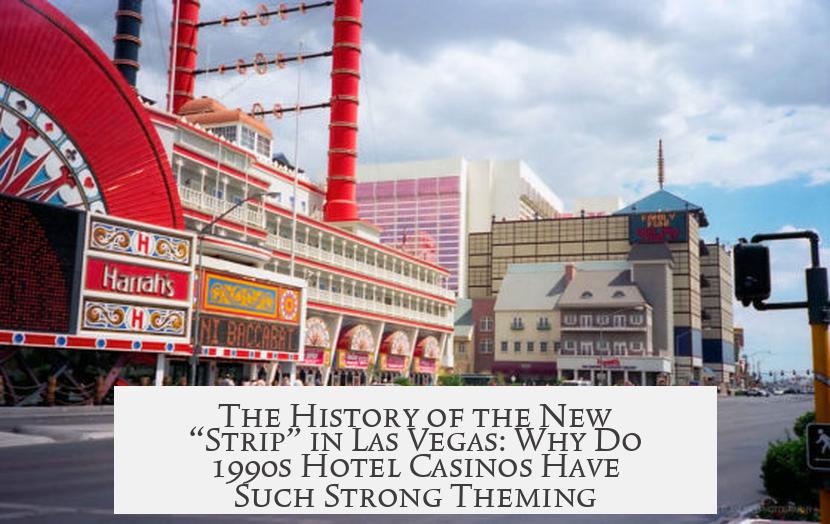
What is the history of the new “Strip” in Las Vegas, specifically why many of the hotel casinos built up through the 1990s have such strong theming?
Simply put, the strong theming of many 1990s Las Vegas hotel casinos springs from a historical shift where gambling stopped being a novelty, and themes became vital hooks to attract visitors in a booming, competitive market. Let’s unpack this fascinating transformation that shaped the iconic Strip of the ’90s.
The story starts with the evolution of casino resorts, progressing through three generations. Each one marks a distinct phase in how developers thought about casinos and their guests.
First Generation: The Humble Beginnings
Back in the early days, land was cheap but money was tight. The Strip’s earliest resorts were practical—imagine a central casino building, some nearby restaurants and theaters, and separate 1-2 story hotel blocks. Nothing extravagant.
Most casinos had about 200-300 rooms initially. They grew as profits increased. By the late 1950s, some resorts like the Sands and Dunes added taller towers, pushing some places near 1,000 rooms.
Style-wise, first-generation casinos carried loose themes. The American West and Miami modern styles influenced the look. Caesars Palace, opening in 1966, was a standout with full-on Roman theming. Circus Circus proudly wore its big top identity.
But most were understated—places like Desert Inn or Hacienda were not elaborately themed. Why? Because gambling was still a novelty. Visitors came for the thrill of legal casino games more than elaborate surroundings.
Second Generation: Size and Integration
The late ’60s ushered in bigger resorts with more integrated amenities. The International (now Westgate) opened in 1969 with 1,500 rooms in a giant tower over a sprawling base filled with restaurants, shopping, bars, clubs, and a large casino floor. This model spread fast.
Las Vegas’s MGM Grand (original version) followed the pattern. It showed that bigger, all-encompassing resorts drew bigger crowds. At this stage, casinos were not just places to gamble but destinations with diverse entertainment options.
Third Generation: Themes Take Center Stage
Then came an evolution that truly changed the Strip’s landscape—the third generation. It began with The Mirage in 1989, a game-changer combining monster-sized resorts with imaginative theming.
By the late ’80s and into the ’90s, gambling was no longer a novelty. Nearly every resort had slot machines, table games, nice restaurants, and hotel rooms. So, how did resorts distinguish themselves? Themes became the magic ingredient.
Why Did 1990s Casinos Have Such Strong Theming?
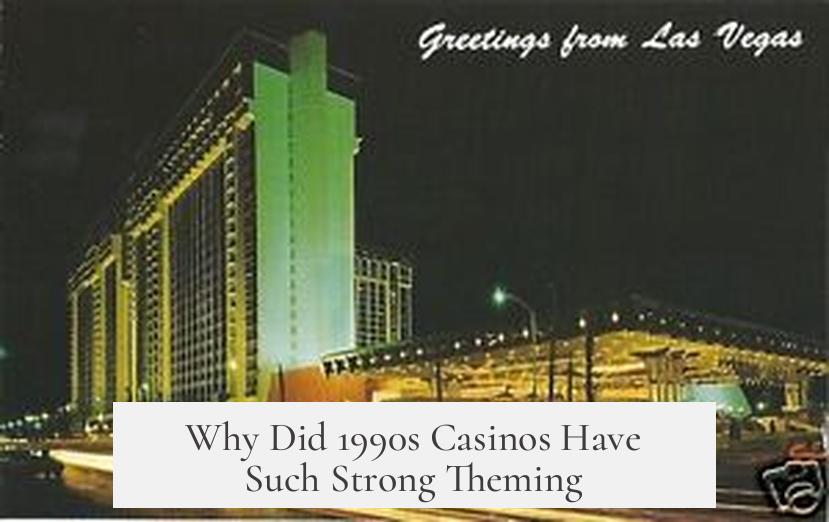
The answer lies in market forces and cultural shifts:
- Gambling Becomes Mainstream: Visitors expected the casino experience to be about more than just betting. The games and amenities were similar everywhere. Resorts realized themes could hook guests, encouraging longer stays and more spending.
- Access to Capital: More investors and financing meant casino operators could afford to take risks and create jaw-dropping environments. Theming wasn’t just decoration; it was an investment with a high return in customer attraction.
- Family-Friendly Vibe: In an effort to expand beyond gamblers, many resorts embraced bright and innocent designs. They marketed Las Vegas as a family vacation spot, with fun themes appealing to kids and adults alike.
Think of the Excalibur’s medieval castle, the Luxor’s Egyptian pyramid, or New York-New York’s skyline—all created to immerse guests in vivid fantasy worlds. These themes weren’t accidental or just flair; they anchored a philosophy that Las Vegas was an entertainment capital for everyone.
The Shift After 2000: Goodbye Themes, Hello Luxury and Adult Appeal
By the 2000s, Las Vegas began to morph again. The themed craziness started to be seen as outdated.
Starting with Wynn (2005), resorts moved away from overt themes toward sleek, luxurious designs. The family-friendly fun gave way to adult-focused experiences in tune with the famous “What happens in Vegas, stays in Vegas” motto.
Newer hotels like Aria offer understated elegance that could be anywhere in the world. Luxor remains a quirky relic, combining Ancient Egypt with slot machines, but today’s trend is less about spectacle and more about high-end experiences.
This shift reflected the broader change in promotional strategies—Las Vegas was no longer just a themed playground but a sophisticated hotspot for adults seeking upscale dining, shows, and nightlife alongside gambling.
What Can We Learn From This Evolution?
- Theming in the 1990s wasn’t mere decoration; it was a strategic response to a maturing market.
- Themes helped resorts differentiate themselves in a sea of similar casino offers.
- Capital influx and legitimacy turned casinos into resorts showcasing immersive environments.
- Las Vegas reacted dynamically to visitor tastes—moving from novelty gambling, to family-friendly fantasy land, then shifting to sleek adult playground.
Next time you stroll the Strip, notice how each resort whispers a story from its time. The 1990s theming dazzles with nostalgia—vivid, fun, and larger-than-life—while newer buildings speak luxury in a toned-down voice.
So, why such strong theming through the 1990s? Because in a city where everyone gambled, it was the themes that dealt the winning hand.
Why did many Las Vegas hotel casinos built through the 1990s have strong themes?
By the 1990s, gambling was common and resorts offered similar games. Themes became a key way to attract visitors. Casinos used strong theming to stand out and create distinct experiences.
How did the development stages of the Strip influence casino theming?
Early resorts had simple designs due to limited funds and novelty of gambling. The 1989 Mirage combined size with strong theming, inspiring a wave of themed resorts in the 1990s as competition grew.
What role did family-friendly philosophy play in 1990s casino theming?
Casinos aimed to attract broader audiences beyond gamblers, including families. Bright, playful themes helped make casinos seem safe and inviting as general vacation spots.
Why did the Las Vegas Strip move away from themed casinos after 2000?
Starting in the mid-2000s, tastes shifted toward adult appeal. Themed resorts were seen as outdated. Newer properties favored modern, sleek designs with less obvious theming.
How did access to capital affect casino theming in the 1990s?
With more capital and legitimacy, casino operators invested heavily in themes. This allowed elaborate designs and attractions to draw in tourists beyond just gambling.
